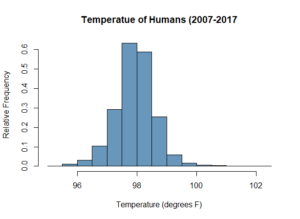Researchers at Stanford University used data from the Union Army Veterans of the Civil War (1860-1940), the National Health and Nutrition Examination Survey (1971-1975), and the Stanford Translational Research Integrated Database Environment (2007-2017) to determine that the mean body temperature in men and women has decreased by 0.03 degrees Celsius per birth decade. The reduction in body temperature is a proxy for metabolic rate and this may help to explain the changes in the health of humans and the increase in life expectancy.
In 1851, Carl Reinhold August Wunderlich measured the body temperature of 25,000 humans and found that normal body temperature was 98.6 degrees Fahrenheit (or 37 degrees Celsius). The mean body temperatures of 578,222 individuals during the period from 2007 to 2017, was found to be 97.99 degrees Fahrenheit. Below is a histogram showing the distribution of temperatures (drawn in R). It seems pretty clear that the mean is below 98.6 degrees Fahrenheit.

Here is a link to the original study. Included in the study is a zip file with all the original data. The file is extremely large (over 70 MB) for the combined data, so analysis in most stats packages will be a challenge. However, R can handle it. If you are using other packages, first import the data to Excel and attempt to cut and paste what you need. The data sets for each individual cohort is a little more manageable.
Okay, so what can you do with this data?
- Fit a normal model to the Stanford data by finding the population mean and standard deviation. Use the model to determine the proportion of individuals whose temperature is above 98.6 degrees Fahrenheit. Compare this to the actual proportions.
- Treat the Stanford data as a population. Obtain 2000 simple random samples of size 9 from the population. Compute the mean of each sample. Draw a histogram of the 2000 sample means. Find the mean of the 2000 sample means. Find the standard deviation of the 2000 sample means. Great for illustrating sampling distributions.
- Are people "cooling off" over time? Run a regression using birth year as the explanatory variable and temperature as the response variable. Again, you might consider randomly sampling from each cohort and building a data set.
- Do people "cool off" with age? Run a regression treating age as the explanatory variable and temperature as the response variable.
- Is there a difference in the body temperature of the 1860-1940 (Union Army Vets) cohort compared to the 2007-2017 (Stanford) cohort? Maybe take a random sample from each cohort and go through a two-sample t-test.
